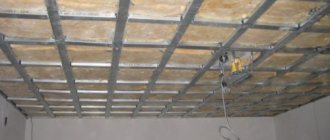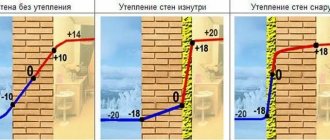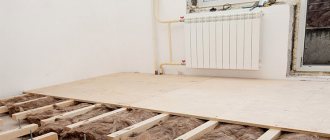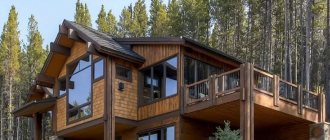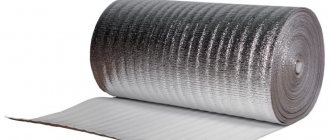Wooden floors are more often than others, especially recently, used in the construction of private country houses and cottages. Floors are constructed both on wooden beams and on reinforced concrete floors.
The thermal conductivity of wood is much lower than that of stone or concrete, making it warmer to the touch. Nevertheless, very often it is necessary to insulate wooden floors, especially on the first floors of buildings.
Choosing floor insulation
Before purchasing insulation, make sure that it meets the basic qualities of insulation:
- Does not emit harmful substances that affect human health;
- Tolerates temperature changes and various weather conditions well. Not subject to destruction under the influence of sunlight;
- Fireproof;
- Good air permeability. Breathable material;
- Durable material with a long service life. It must perform its function well for a long time without replacing components;
- Easy to install. For a novice builder (homeowners with no construction experience), it is important to use a material that is easy to use;
- It retains heat well and also serves as a sound insulator.
Main stages of work
Insulation of a wooden floor in a private house is carried out in stages. You need to do the following:
- carry out an inspection of the condition of the subfloor and supporting structures (lag);
- choose a method of insulation, decide which insulation is best to use;
- purchase the necessary materials and equipment;
- carry out preparatory work;
- install waterproofing, insulation and related materials on the subfloor;
- lay a layer of sheathing and a finished floor covering on the floor.
The main task is the correct choice of installation method and insulation. If the house uses an old floor, you need to decide whether it can be continued to be used, or whether a complete replacement of the floor is needed. In addition, you need to determine the direction of installation - from below or from above. All subsequent actions depend on what decisions are made.
Types of insulation
On sale you can find three types of insulation, each of them has its own scope of application.
To insulate the floor with your own hands, it is better to know the properties of each of them.
The following types of insulation are distinguished:
- Mineral
- Polymer
- Wood-based panels
Mineral insulation
Environmentally friendly insulation. There are several types of mineral insulation. Let's look at the characteristics of each of them.
Mineral wool. It is produced by heating rocks and transforming them into thin threads. These threads are subsequently secured with an adhesive. It is sold in the form of rolls of mats.
The advantages of mineral wool include low cost, good noise and thermal insulation. Mineral wool does not harbor rodents or mold. Mineral wool is a breathable material with a long service life.
Mineral wool has several varieties:
- Stone;
- Basalt;
- Glass wool;
- Slag wool.
Glass wool
Glass wool is made by heating sand, lime, soda, and borax to 1400 degrees. The finished composition is passed through the container to form thin strands of string. Subsequently connecting them into a single layer.
- Glass wool retains heat well and does not allow sound to pass through.
- Quite durable material that is not subject to destruction under the influence of vibration.
- It is fireproof and does not burn. At a temperature of 450 degrees it disintegrates, losing its properties.
When working in glass wool you must be extremely careful. Since glass fibers break into small cutting particles under physical impact. When they get on the skin they cause itching. Fibers entering the respiratory tract are extremely dangerous.
Basalt wool
Basalt wool is made from rocks that are heated at a temperature of 1500 degrees. At this temperature, the steam breaks down into fibers, which are then fixed with adhesives.
- It is a good sound and heat insulator.
- Safe to use and does not contain any caustic substances.
- Does not lose shape after a long period of use.
- It is waterproof, does not emit hazardous substances, but when heated to 700 degrees it releases phenol.
- Suitable for insulating wooden floors, walls and roofs.
Slag wool
Made from metallurgical waste. Just like glass wool. When heated to 300 degrees it begins to melt. It deteriorates when exposed to moisture. Service life is from 10 to 15 years. Refers to insulation materials with a low price category.
Foam glass
Like all heat insulators, it is a good sound insulator. Environmentally friendly and does not emit harmful substances. Does not burn under high temperatures and is not afraid of moisture.
Foam glass is not susceptible to the formation of mold and other bacteria. Rodents will also not grow in it.
- Foam glass tolerates various climatic conditions well, maintaining its structure.
- Foam glass also has a long service life.
It can be used in various regions, even where humidity levels are high or severe frosts occur in winter.
Expanded clay
Burnt clay granules suitable for insulating concrete floors.
- Due to its structure, it does not allow heat to pass through.
- Quite easy to use.
- The material is not subject to fire.
- Refers to insulation materials of a low price category.
- Does not emit harmful chemicals. Tolerates frosts.
The disadvantages include the fact that when working with it, it generates dust; you need to work in a respirator.
Types of wooden floors
The method of insulation largely depends on the design of the wooden floor. There are three types of it:
- planks;
- plywood;
- parquet.
Plank floors are made by laying boards over joists - wooden blocks mounted at a certain distance. Such structures are very often made in wooden houses. Plank floors can immediately form the top finishing coating, or they can be the basis for some other decorative material. In the second case, such floors are called subfloors.
To ensure that the boards in the spaces between the joists do not sag from the weight of people or any objects standing on the floor, they are connected to each other when laying. To do this, the boards are tongue-and-groove, creating a groove on one edge and a tenon on the other. When installing the floor, the boards are joined together, the tenons fit into the grooves, forming a massive wooden shield lying on the joists.
Plywood floors are used mainly as subfloors. Plywood is also laid over the joists and secured. Any covering can be mounted on top of plywood: linoleum, parquet, laminate.
Parquet floors are a series of slabs of hardwood that are laid in a specific pattern to form a decorative pattern. Parquet can be laid either on a rough wooden floor or on a concrete floor.
Depending on the type of floor, insulation methods will vary. To choose the right one, you need to take into account the purpose of the building - is it a residential house or a summer house. Much also depends on the supporting structures; insulation methods in wooden, brick or aerated concrete houses may vary. It is also necessary to take into account the presence or absence of a basement under the floor.
Polymer insulation
This category is divided into:
- Expanded polystyrene foam;
- Polyurethane foam;
- Foamed polyethylene on a foil base;
- Penoizol-liquid foam.
Installation of different types of thermal insulation
Options for thermal insulation are offered that differ in the technological process (spraying and laying insulation).
Video - Insulating the floor above a cold basement
Spraying of polyurethane foam
Before starting work, it is necessary to dismantle the floor covering. The rough foundation and logs should remain.
Step 1 . It takes specialists about an hour to prepare the equipment for work. The future foam (polyol) and hardener (isocyanate) are mixed under high pressure (150 atmospheres). To insulate the floor, a closed-cell material is used that is not afraid of moisture (open-cell polyurethane foam is more suitable for insulating interior partitions).
The future foam is mixed with a hardener
Step 2 . It is better to cover surfaces that are of value (to a height of about 0.5 meters from the floor along the entire perimeter), since during work the finely dispersed mass can stain objects and cladding.
Sockets are covered with film
Step 3 . The flooring begins. Work must be carried out in protective suits and masks (only half an hour after application the foam becomes completely harmless).
Floor pouring begins
It is necessary to ensure that no open cavities are left. The result is a monolithic base made of foam insulation.
Monolithic PPU coating
Step 4 . The room must be ventilated. What needs to be done after the foam has hardened? Clean it off the beams. After this, the finishing coating can be laid. If excess polyurethane foam has formed, it can be removed with a regular stationery knife.
Expert opinion
Masalsky A.V.
Editor of the “floor screed” category on the Pol-exp.com portal. Engineering systems specialist.
As you can see, the technology for installing thermal insulation in this way is not complicated. In addition, it allows you to get the job done very quickly. The insulation will last at least 50 years. The only thing is that it needs to be protected from ultraviolet radiation. Unlike open-cell material, which mice can, in principle, chew through, they cannot overcome this coating.
Laying mineral wool insulation
Such work is completely within the capabilities of every home owner. This is the floor that needs to be insulated (there is no finishing coating, but if it is present, it will have to be dismantled).
This floor needs to be insulated
Step 1 . All joists and rough boards must be treated with an antiseptic.
Step 2 . A vapor barrier is laid on the surface of the rough base. The canvases should be placed overlapping (if there is no moisture penetration from below, you can skip this step). If you attach the material with double-sided tape, this will ensure the tightness of the coating.
Laying vapor barrier material
Step 3 . The insulation will be made of mineral wool 5 cm thick, laid in three layers. The first layer is made of rolled material to minimize the number of joints. It needs to be cut using a construction knife so that it fits tightly between the lags (it is recommended when cutting to ensure that the width of the thermal insulation is about a centimeter greater than the distance between the lags). Having straightened out, it will fill the entire space.
Mineral wool is laid between the joists
Step 4 . Next, the slab material, cut to width, is laid.
Mineral wool in slabs
During installation, the offset of the slabs of adjacent rows must be observed. This must be done so that the seams are located at a distance from each other. Thus, the thermal insulation characteristics of the coating will be higher.
Thermal insulation boards laid
Of course, it is easier to work with slabs, they are denser, and easier to lay.
Step 5 . A vapor-waterproofing membrane is also overlapped on top (smooth side down). A construction stapler is perfect for securing. The coating should extend slightly onto the walls of the building.
The membrane should extend slightly onto the walls
It is recommended to secure the edges of the membrane to the walls with double-sided tape (the protective film is then removed).
The edges of the membrane are fixed with double-sided tape
The floor is ready for finishing.
You can start finishing
Wooden houses are always associated with comfort. However, for your home to be truly comfortable, you need to take care of its insulation. Thermal insulation of the floor is the most important step, which is usually performed immediately after the construction of the structure.
Expanded polystyrene
Quite a popular type of insulation. Popularly known as polystyrene foam. Due to its low weight it does not add additional load. Withstands moisture well.
When insulating the floor, you can use the small thickness of the sheet. Foam plastic is also one of the inexpensive insulation materials.
When burning, foam releases harmful chemicals.
How can you insulate the floor?
When choosing a material, you need to understand that all types of insulation have different thermal conductivity coefficients. Of course, the lower it is, the better. This means that the insulation has a good ability to retain heat inside the room. The lower this indicator is for the material, the thinner the coating layer will be needed to protect the building.
Table. Thermal conductivity coefficients of different types of insulation.
| Material | Thermal conductivity coefficient, W/(m*C) |
| Expanded clay | 0,1 |
| Stone wool | 0,038…0.047 |
| Glass wool | 0,035…0,05 |
| Extruded polystyrene foam | 0,028…0,04 |
| Polyurethane foam | 0,02…0,04 |
| Ecowool | 0,04 |
| Linen insulation | 0,038 |
| Penoizol | 0,03…0,4 |
| Styrofoam | 0, 0033…0,038 |
| Sawdust | 0,07…0,1 |
In addition, it is necessary to pay attention to the density of the product, its moisture, fire resistance and other characteristics. An important aspect for owners of country houses is the interest of insulation for rodents. After all, for example, the fire resistance of a material is unlikely to help if a wooden house catches fire. And the places where mice live and their passages, which they make in thermal insulation, can seriously deteriorate the characteristics of the laid coating.
Another important aspect is the design of the building; the type of thermal insulation largely depends on this. The climatic conditions of the region also cannot be discounted.
Expert opinion
Masalsky A.V.
Editor of the “floor screed” category on the Pol-exp.com portal. Engineering systems specialist.
In general, all types of insulation can be divided into three categories: bulk, slab (or roll) and sprayed. Everyone chooses for themselves which type is more convenient to install.
Important ! I would like to note that if piece products have to be joined, adjusting the products to the required size, then when spraying mixtures, seams and the formation of cold bridges can be avoided.
Foamed polyethylene on a foil base
Foamed polyethylene is considered one of the best insulation materials for floors. It is produced by foaming polyethylene with liquefied gas. Foil is applied to one side of the composition to reflect heat.
The finished product is packaged in rolls, slabs or sheets.
- The sheet is not afraid of moisture and can be used in rooms with high humidity.
- Can be installed in kitchens and bathrooms and even in baths.
- Retains its original appearance even under high loads. Not afraid of contact with gasoline and various alkalis.
- Installation of foamed polyethylene is quite simple; the sheets are not massive in size.
- The sheet must be laid with the foil side facing up.
Thus, the heat will not only be retained, but also reflected back into the room.
The need to carry out work on thermal insulation of the base
When constructing frame, log or timber structures, despite the fact that wood is a warm material, it is not always possible to ensure the optimal ratio of thickness-strength-thermal conductivity of the materials used. Air currents coming from the ground penetrate the home through the base. The main weak point is the seams in the finishing. In the same way, heat leaves the house. To make the rooms comfortable to stay in, it is necessary to take measures to thermally insulate the base. In addition, a well-calculated insulating structure at the design stage will help save on building materials.
Heat loss in a private house
Important! Up to 15% of thermal energy can escape through cracks in floors in winter.
Expert opinion
Afanasyev E.V.
Chief editor of the pol-exp.com project Engineer.
In addition to deteriorating the microclimate inside the building, disturbances in temperature and humidity conditions greatly harm wooden elements. Wood may lose its performance characteristics, which ultimately leads to the need for restoration work, and in advanced cases, to the construction of a new house.
However, we are not talking only about the floor of the first floor, despite the fact that it is the coldest. Interfloor ceilings also need to be insulated. The base of the attic also needs thermal insulation, even if it is not used for living. Otherwise, nothing can prevent the heat from escaping to the street.
Insulation for wooden floors in a private house
What functions does insulation perform?
- Allows you to provide good climatic conditions for residents.
- Helps significantly reduce heating costs.
- Prevents the appearance of high humidity in rooms, minimizes the risk of condensation on the surface of the wood. As a result, the tree is not subject to biological damage (pathogenic microorganisms such as mold or mildew do not appear on it) that destroy the wood.
Insulation using mineral wool
It is much more logical to carry out work on insulating the foundations simultaneously with the construction of the house. This will help save a lot of money, time and finances. However, if necessary, you can make an already constructed building comfortable. In this case, you can go in two ways: install thermal insulation over the laid coating or carry out partial dismantling of the structures. As a rule, insulation of the floor from above is carried out when it is not possible to get to the base from the bottom (for example, there is no basement or the base is very low).
There are several ways to insulate a floor
If you are confident in the quality of the laid finishing covering (for example, a floorboard), you don’t have to remove it, but usually laying thermal insulation involves disassembling the floor down to the joists (beams on which the finishing lining is mounted).
All work on installing floor insulation can be done independently, without turning to construction companies for help, whose services are not so cheap. And the choice of material for base insulation today is very wide, which allows you to satisfy the needs of customers with different needs and financial situations.
Prices for Knauf mineral wool
mineral wool knauf
Algorithm for floor insulation in a private house
Photo of floor insulation
Calculation of average insulation thickness
The thickness of the thermal insulation layer is an important parameter. It is calculated for each house individually and depends on the design features of the building, climatic conditions characteristic of the area, and the type of insulation chosen.
The formula for calculating the average thickness of the thermal insulation layer is prescribed in SNiP 02/23/2003 “Thermal protection of buildings”
. It looks like this:
insulation thickness =
R
x A,
where R is the thermal resistance of the building structure, standardized for a specific region (this value can be found from a special map diagram in the appendix to SNiP);
A
– thermal conductivity coefficient of the insulation (this value is indicated in the instructions for the thermal insulation material or it can also be found in SNiP).
If it is necessary to lay a thin layer of insulation, experts advise using extruded polystyrene foam or materials in rolls or mats. The second option provides greater strength and elasticity.
Insulation of interfloor ceilings
In the first case, the insulation dampens airborne noise: human speech, music, etc. In the second case, the structure is also perfectly insulated from impact noise - steps, jumps, etc.
Proper sound insulation of interfloor ceilings is the key to comfortable living for all family members.
Is expanded clay suitable?
This material is also considered one of the most suitable for the purpose of creating a warm indoor microclimate. Expanded clay insulation is often used in Russia because it is an affordable material and easy to work with.
After leveling the floor, you can proceed to the main installation process.
Create an expanded clay pillow with a layer of approximately 15-30 cm, but not less than 10 cm, as it may not be enough for reliable protection. It is recommended to focus on a layer close to 30 cm in order to guarantee the effectiveness of this floor insulation option.
With the help of metal profiles it is necessary to divide the space into many parts. If it is not possible to form a flat surface, then it is allowed to place wooden pads under such a profile.
Use plastic film to create a waterproofing layer, as this material is susceptible to moisture penetration.
- Floor painting - painting technology for wooden and concrete floors (80 photos)
- Marmoleum - installation basics and rules for laying natural linoleum (70 photos)
- Cork flooring - features of coating application and installation rules (100 photos)
It is recommended to apply a concrete version of the screed over the waterproofing layer, which will help strengthen the structure. This is necessary to reliably protect expanded clay from moisture. Other ways of protecting it are not excluded.
Heated floor systems
Underfloor heating systems have proven themselves in creating a comfortable microclimate in the house. They are satisfied:
- based on water heating;
- with connection to a power source.
Insulation with a metallized coating is used, on top of which small-diameter pipelines, electrical mats, cables or infrared emitters are laid. The reflective layer directs thermal radiation into the room, preventing heat loss. The structure is covered from above with a screed or flooring material.
Warm floors for comfortable living Source utepleniedoma.com
Advantages of the systems:
- Ease of installation.
- Economical in operation.
- Small thickness of structures.
- Even heat distribution.
- Environmentally friendly.
- Reliability.
- Safety.
A warm floor can be the main or additional element of the heating system of a private home.



